Warcraft III Beta Report: The Undead Scourge
Will the merciless undead scourge be the strongest of the four factions in Warcraft III? Learn all about them in this in-depth preview of the beta version of the game.
The Death Knight
Evil swords in hand, these arrogant undead warriors charge into battle on nightmarish steeds. The death knight is essentially an anti-paladin, and he's highly effective in close combat, thanks in part to his various spells. Death coil deals out damage to a single target and transfers its life force to the death knight; death pact instantly kills one of the death knight's own allies, transforming that creature's life force into a magical barrier, and animate dead, the death knight's ultimate spell, temporarily restores un-life to a number of the death knight's slain allies, letting them continue the fight.
It's safe to say that Warcraft III is the single most highly anticipated computer game of this year. Legions of gamers the world over have been extremely eager to get their hands on Blizzard's forthcoming real-time strategy game so they can reassume command of the armies of orcs and humans and wage fierce battles against their foes. How can you make a game live up to such stupendously high expectations? Simple--just test it with a dedicated sample audience to make sure it all works perfectly, and that they all love it, before you decide it's done.
Now that the Warcraft III beta test is going strong, with about 5,000 players logging in countless feverish hours since last week, we've noticed something surprising--it seems as though the orcs and the humans, the two factions that define the Warcraft series, actually seem to be the least popular factions. Instead, a lot of players seem to be gravitating toward the night elves, as well as the undead scourge--a new faction given rise to by the death knights of Warcraft II. Warcraft III's undead aren't just a hodgepodge of reanimated zombies and skeletons, though--they are a full-fledged army with an evil ambition.
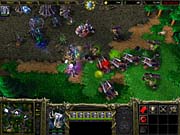
You may recall that Warcraft II's death knights fought alongside the orcs. These shadowy horsemen tenuously allied themselves with the savage orcs in order to overthrow a common enemy: the human alliance. Now the death knights are heeding a higher calling. Their master, the Lich King Ner'zhul, has managed to grow his undead armies to the point where the aid of the orcs is no longer necessary. As the undead march deep into human territory from the frozen wastelands of Ner'zhul's domain, the rest of the world is left to wonder just how far these fearless warriors are willing to go, and to what ends.
Like Frankenstein's monster, in gameplay terms the undead consist of a patchwork of concepts and ideas from Blizzard's previous games. So in spite of the unsettling appearance of its pale-skinned units, if you're a veteran of Blizzard's games, you may actually find that the undead aren't quite as alien as they may first appear. You'll find that the way they must build and expand their base and a number of their unique units and special abilities are similar to certain concepts from games like Starcraft and Diablo II.
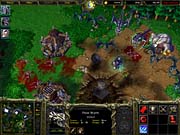
Don't worry--the undead aren't just Warcraft III's answer to the zerg (although zerg players will likely feel most at home with Warcraft III's undead compared with any of the other races). After all, this race has a number of unique abilities and some original and fascinating units. Every race in Warcraft III has certain advantages over the others. The undead's advantage lies in its ability to quickly replenish its forces by reviving slain corpses or by restoring the health of its units through unorthodox means. This keeps the enemy guessing, as it can be very difficult to gauge just how large an undead army truly is. Undead units are also some of the most powerful in terms of their sheer strength--only the orcish units have comparable muscle.
So, what's the difference between a necromancer and a lich? What's that disgusting contraption called the meat wagon? And what's the deal with the infested lands that surround all undead bases? Find out next.
The Undead Forces
The undead emerge from the necropolis, an ominous structure surrounded by hopelessly corrupted soil, known as the blight. Blight is highly unpleasant to the living but has regenerative powers for undead units. The undead don't mine for gold like the human peasants or orc peons--they must first create a haunted gold mine. Then up to five of the undead's acolytes, its subservient workers, can surround the structure and begin an alchemistic ritual, transmuting gold into precious resources for their undead armies.
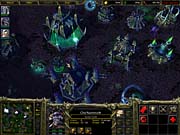
Rather than construct buildings manually, acolytes summon them into existence, and once the summoning ritual begins, the acolyte can move on to perform other tasks. In practice, acolytes build just like the protoss probes from Starcraft. Later in a match, acolytes gain the ability to turn themselves into shades, which are defenseless but invisible ghostlike units perfectly suited to scouting.
Acolytes must summon structures called ziggurats in order to sustain growing numbers of undead units. Initially useless, ziggurats can be individually upgraded to become ghostly weapons that are perfect for defending against both ground and air targets.
The Dread Lord
Demonic beings known as dread lords are generals in the undead army. They tear their victims apart with their razor-sharp claws and leave darkness and despair in their wake. In addition to their great fighting skills, dread lords have a number of unique abilities: carrion swarm summons a ravenous cloud of bats that sweeps out in an arc, damaging all enemies in the way; sleep incapacitates a single foe, knocking it out of the battle; vampiric aura gives the dread lord and any nearby allies a life-stealing attack; and dark summoning, the dread lord's ultimate skill, will instantly teleport a group of the dread lord's allies to his position.
Acolytes have one particular disadvantage when compared with other workers: They cannot gather wood. Instead, the undead employ ghouls, whose sharp talons can cut down trees easily, for this purpose. Actually, ghouls are far more efficient at woodcutting than the other factions' workers. Ghouls also double as the basic infantry unit for the undead. They can gain an ability that increases their attack speed, as well as the ability to devour the fresh corpses of friends or foes in order to recover all their health.
Ghouls are only one of several types of creature that emerge from the crypt. Another is the crypt fiend, a massive spiderlike creature that spews clouds of stinging insects upon its foes. Crypt fiends can only attack ground targets, but they may learn the web ability, which lets them immobilize flying units, dragging them to the earth so that units like ghouls can rip them to shreds.
Later, the crypt also lets you produce gargoyles, ghastly winged creatures that can attack both flying and ground targets. Gargoyles are very powerful in flocks, and they're especially useful for striking lightly defended expansion towns. Gargoyles can optionally gain the stone form ability. They cannot move or attack in stone form, but they gradually regenerate their health and become much more resistant to damage. The undead have another flying unit, a massive skeletal dragon called the frost wyrm, whose freezing breath can put even the mightiest warrior in a state of shock. This hardy creature can gain an ability that freezes enemy structures, grinding production to a halt.
The structure called the slaughterhouse is home to the undead's abomination and meat wagon units. Abominations are extremely strong ogrelike creatures that are excellent in close combat. Meat wagons are fragile but long-ranged siege weapons that fling globs of corrosive substances at enemy installations. Meat wagons can also gather corpses, which are useful both to ghouls and necromancers.
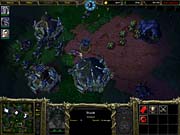
Corpses are important to necromancers because necromancers have the power to raise the dead--any corpse on the battlefield can be transformed into a pair of skeletons that will do the necromancer's bidding. Necromancers also learn unholy frenzy, which greatly increases a unit's rate of attack, but diminishes that unit's life force. Finally, necromancers learn corpse explosion, which detonates corpses on the battlefield, injuring all enemies in range. This effect should be very familiar to Diablo II players.
The banshee plays more of a supporting role. She starts with the curse spell, which causes enemies to occasionally miss their targets with their attacks. She can also learn and anti-magic shell that prevents an allied unit from being targeted by enemy spells, as well as possession, which allows the banshee to permanently possess the body of an enemy unit.
How do all these forces work in conjunction? Are the undead's misshapen armies truly a match for the organized, highly trained factions they are up against? Find out next.
They Are Death Incarnate
The Lich
Once mighty orcish shamans, skeletal fiends known as liches are even more dangerous in their afterlives. Their frail appearance belies their truly staggering power. Liches attack ground and air targets with frost bolts, but they eventually gain more powerful abilities: frost nova slows and damages enemies surrounding the lich; frost armor surrounds allied units in a barrier that will damage and slow any assailant; dark ritual slays one of the lich's allies but transfers the unit's life force into the lich's mana reserves; and death and decay, the lich's ultimate spell, devastates everything--buildings and creatures alike--within a wide radius.
The primary purpose of the Warcraft III beta test is to tweak the gameplay balance in order to ensure that all the game's factions have an equally good chance of winning battles. At this early stage in the beta, many players agree that the undead could use some work. They have particular weaknesses and a few seemingly overpowering strengths. Fortunately, Blizzard is already on the case--a recent patch has already helped even things out.
One problem facing the undead is that they have to construct a relatively expensive haunted goldmine before they can begin gathering resources. Once a goldmine is depleted, the structure disappears, forcing the undead to construct another source of revenue. Unfortunately, if they have less than the cost of a new haunted goldmine in their reserves at that time, the they'll be out of luck. The other factions don't have this particular problem, but Blizzard plans to address it before the game is released.
The undead have a few other notable weaknesses right now. Their crypt fiend, a ranged attack unit, is large and rather expensive (in a recent patch, Blizzard reduced the cost), but it's only able to attack flying targets except with its web ability, which must be micromanaged. The other factions all have effective antiair units, but the undead have nothing of the kind. Ironically, the undead do have an extremely powerful flying unit, the gargoyle. In larger packs, gargoyles are capable of killing anything quite easily. One-on-one Battle.net matches between players both using the undead faction often devolve into a race to see which one can build more gargoyles more quickly. Recognizing the issue, Blizzard recently suggested that gargoyles would be adjusted to emphasize their anti-air capability. They may yet lose their ability to attack ground units altogether.

Some of the other units and special abilities seem to need tweaking. The frost wyrm, ostensibly the biggest and toughest unit on the undead side, doesn't seem particularly strong, and its frozen breath special ability currently isn't very useful. The abomination, while certainly scary, is more expensive but only marginally tougher than units like the humans' knight or the orcs' taurens (Blizzard just reduced the cost of this unit as well). Also, the banshee's anti-magic shell seems far too costly to be of much use.
One of the most popular undead units is the necromancer, due to his ability to summon large armies of skeletons. In groups, necromancers can seem almost unstoppable, as the skeletons can be quite deadly in numbers. It's possible that the necromancer's ability to raise the dead will be mitigated somewhat. On the other hand, his unholy frenzy ability, which increases a unit's attack speed but drains its life, could use a boost--currently, the amount of damage it does to your unit seems to outweigh or at least offset its usefulness. Also, the corpse explosion spell seems too weak, especially when the alternative is to raise more skeletons.
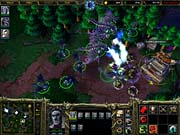
The undead's heroes are also arguably just lesser versions of races' heroes. The death knight's animate dead ability is similar but not as powerful as the human paladin's resurrection. The dread lord's carrion swarm simply seems underpowered. The lich's dark ritual forces you to kill one of your own units in exchange for more magic power, while the human archmage gains an ability to naturally increase his mana regeneration. Perhaps these factors will be offset by the undead's other strengths.
These various issues are nothing that a few patches couldn't address. The undead may also gain a few additional abilities over the course of the beta test--for instance, necromancers were at one time supposed to be able to summon skeletal archers as well as swordsmen. If they gain this ability, it could seriously help address the issue of the undead's lack of surface-to-air attack power.
Beyond all that, most of the beta testers agree that the undead are decidedly cool. Far from the mindless fiends you'd expect, they are clever, calculating warriors that make a great addition to the Warcraft universe. In the meantime, it will be up to Blizzard to make sure that the forces of the undead end up just as powerful as they seem by the time Warcraft III is finally completed later this year.
Got a news tip or want to contact us directly? Email news@gamespot.com
Join the conversation